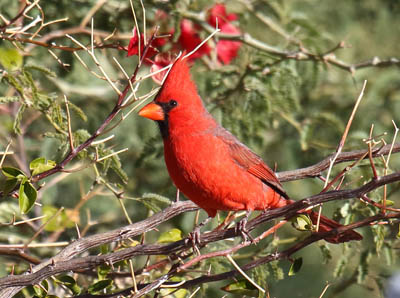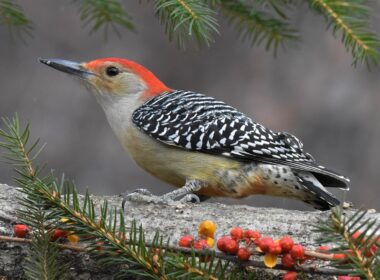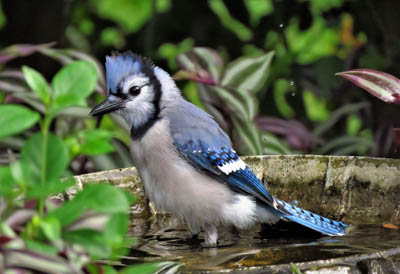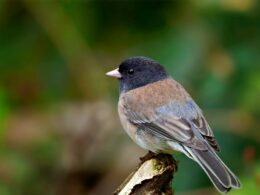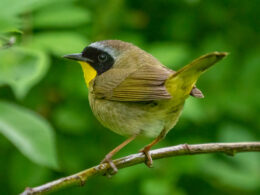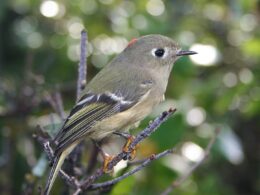Last Updated on January 24, 2024 by Greg Gillson
Did you see a brightly colored red bird, orange bird, or yellow bird in Vermont and wonder what it was?
This page is for you!
This article shows you photos and identification of some of the most common birds in Vermont based on color.
The list of birds found in Vermont includes over 390 species. So, I can’t show you all of them. I’m going to assume that you saw a common bird of this color, but you certainly could have seen something less common, or even rare!
Shape (including the shape of the bill) and size are often more helpful in starting to identify a bird than the color. In fact, most birds in North American can be easily identified with a black-and-white photo!
Many birds are multi-colored, so that it may be hard to pick out a dominant color. Males and females may be colored quite differently. And some color patterns are similar among otherwise dissimilar species.
Nevertheless, I’m going to try to pick out some of the birds that you are most likely to see in backyards or towns. And I’ll show a few others that I get asked about a lot.
The birds with a noticeable amount of red on them in Vermont covered in this article are:
- American Robin
- Northern Cardinal
- House Finch
- Purple Finch
- Ruby-throated Hummingbird
- Rose-breasted Grosbeak
- Common Redpoll
- Scarlet Tanager
The birds with a noticeable amount of orange on them in Vermont covered in this article are:
- Red-breasted Nuthatch
- American Redstart
- Barn Swallow
- Baltimore Oriole
- Wood Thrush
- Eastern Towhee
The birds with a noticeable amount of yellow on them, including lots of yellow and black birds, in Vermont covered in this article are:
- American Goldfinch
- Common Yellowthroat
- Cedar Waxwing
- Northern Flicker
- Yellow-rumped Warbler
- Yellow Warbler
- Black-throated Green Warbler
- Great Crested Flycatcher
- Northern Parula
- Magnolia Warbler
- Pine Warbler
Red birds of Vermont
Birds get the red, orange, and yellow in their feathers from carotenoids in the fruit, seeds, and plants they eat (source).
These carotenoid colors combine with melanin to form an infinite range of red feathers–pink, rusty, scarlet, violet, red-orange.
The following are red birds that you are most likely to see in Vermont.
American Robin
These are familiar lawn birds with red breasts.
 |
| American Robin. Greg Gillson. |
Male American Robins are brownish-gray above with a brick red breast. Females are paler orange below and paler gray above.
They are widespread in open country with scattered deciduous trees, residential areas.
American Robins are year-round residents throughout Vermont.
Northern Cardinal
These are one of the most common backyard birds in the eastern United States. Their bright red color and unique head profile makes them instantly identifiable to most people–whether they are bird watchers or not!
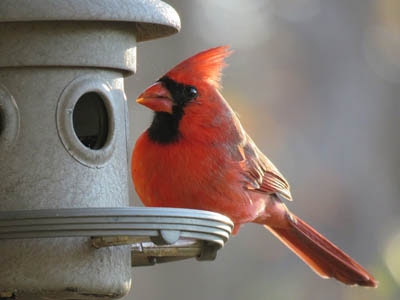 |
| Northern Cardinal. GeorgeB2 from Pixabay. |
Males of these large seed eaters are bright red with a black face and red crest.
Females replace most of the red with brown. The bill is large and orange.
These birds are found in woodlands, stream edges, residential areas.
Northern Cardinals are year-round residents throughout most of Vermont, absent in northeastern Vermont.
House Finch
When people ask about a bird with a red head at their feeder, it is usually this bird.
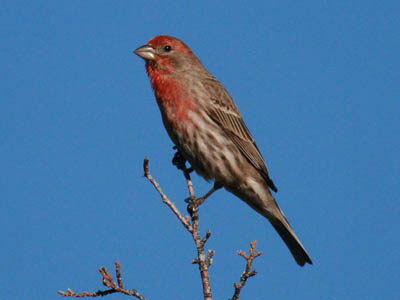 |
| Male House Finch. Greg Gillson. |
Males of this dusty brown striped finch have red limited to the head (specifically the forehead and eyebrow), breast (chest), and rump. The red coloration tends toward orangish and may rarely be yellowish.
Females are streaked, similar to the males but without red. They lack any strong pattern on the face and head.
Note the small round head and curved upper ridge on the bill.
Some people call these red-headed sparrows. Sparrows and finches are similar, but in general, male finches are brighter than the females and tend to hang out more in trees. Sparrow genders are usually quite similar in coloration and tend to feed mostly on the ground.
These birds are common in residential areas, especially at bird feeders. In the West more widespread in arid regions near water.
House Finches are year-round residents throughout Vermont.
Purple Finch
Forest finches of the foothills, delicately frosted in pinkish-red.
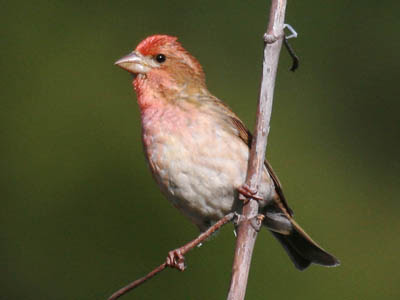 |
| Male Purple Finch. Greg Gillson. |
Told from more common House Finch by bigger square or peaked head, bigger bill, lacks sharp striping below, deeply notched tail. Red covers all plumage.
Females lack red color, shows strongly patterned dark ear patch outlined all around with a pale stripe, is heavily streaked below.
Found in foothills and damp mountains conifers and mixed woods. Visit feeders, but less frequently than House Finches.
Purple Finches are year-round residents throughout Vermont.
Ruby-throated Hummingbird
These red-throated birds are the only hummingbird nesting in the eastern United States.
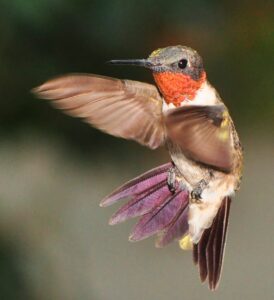
Males are dark green above and on the belly. They have a white upper chest. The throat is ruby-red.
Females are green above, white below, including white throat.
These birds are found in woodland edges, residential yards. Readily come to hummingbird feeders.
Ruby-throated Hummingbirds are summer residents throughout Vermont.
Common Redpoll
These frosty pink and red birds are northern relatives of the goldfinches.
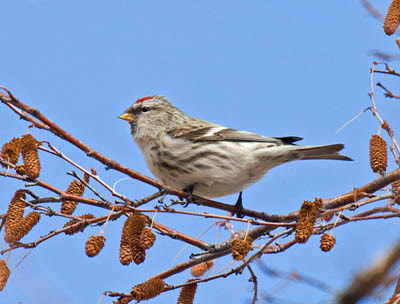 |
| Common Redpoll. Greg Gillson. |
These birds are frosty white in winter with brown striping above and on the sides. Both genders have red caps, black around bill and chin. Adult males have red upper breast. Immatures less red.
These birds are found in weedy fields and alder and birch trees in winter. Come to thistle feeders.
Common Redpolls are winter visitors throughout Vermont.
Rose-breasted Grosbeak
These birds with the red breast and huge pink bill sing beautiful robin-like songs from the tops of trees.
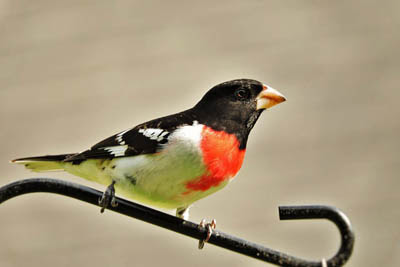 |
| Male Rose-breasted Grosbeak. Susan Killian. Pixabay. |
Males have black hood and upper parts. White under parts. Large white wing patches. Huge pink bill. Inverted bright red triangle on the breast.
Females are brown above, face with broad stripes, white throat. The under parts are buff with many thin brown streaks. Pale bill.
These birds inhabit deciduous and mixed forests. Shade trees in town. Come to feeders.
Rose-breasted Grosbeaks are summer residents throughout Vermont.
Scarlet Tanager
A brilliant red and black bird!
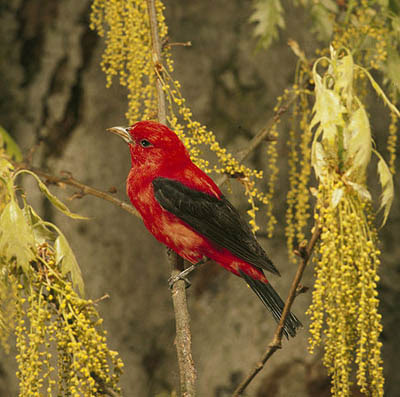 |
| Male Scarlet Tanager. USF&WS. Public Domain. |
Males are unmistakable with brilliant red with black wings and tail.
Females are olive-green above, darker wings and tail, yellower under parts. Pale bill.
These birds live in deciduous woods.
Scarlet Tanagers are summer residents throughout Vermont.
Orange birds of Vermont
True orange-colored birds are not that common. Many birds that I have here are paler rusty.
The common pattern is an orange body and black or brown wings and tail. Another common pattern is for the orange to be restricted to the under parts.
The following are orange birds that you are most likely to see in Vermont.
Red-breasted Nuthatch
These active little red-breasted birds crawls all around on the trunk and big branches of conifers. They search crevices in the bark for insect food.
 |
| Red-breasted Nuthatch. Greg Gillson. |
These tiny birds have blue-gray backs and a black line through a white face. Some males can have quite bright rusty red under parts. Some females can have quite pale buff-colored under parts. Most birds show an orange-cinnamon breast color.
Found nearly exclusively in conifers. Readily come to feeders.
Red-breasted Nuthatches are year-round residents throughout Vermont.
Barn Swallow
These orange-bellied birds are a familiar sight across North America in summer.
 |
| Barn Swallow. Greg Gillson. |
These birds are purple-blue above with orange under parts and long forked tails. The color of the underparts in winter or on females are often cinnamon or buff-colored, but breeding males can be brighter orange-red.
These birds swoop low over fields and wetlands at lower elevations. They may build their mud nests in rafters on porches, garages, or other out-buildings.
Barn Swallows are summer residents throughout Vermont.
American Redstart
In flight these small warblers flash orange or yellow in the wing and base of the tail.
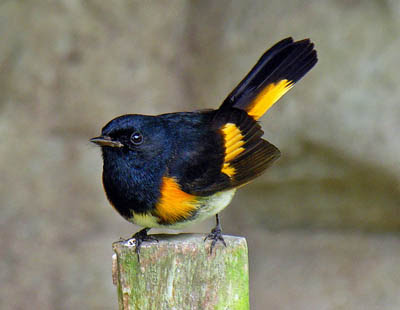 |
| American Redstart. Dennis Jarvis. Flikr. CC BY-SA 2.0 |
Males are black above, white on the belly. They have bright orange patches on side of breast, wings, and base of the tail.
Females are grayer, especially on the head. The orange of males is replaced by yellow on the females.
These birds are found in regenerating woods after a clear cut, and willow tangles along streams.
American Redstarts are summer residents throughout Vermont.
Baltimore Oriole
These bright orange and black birds are fairly common breeders in wooded areas in the East.
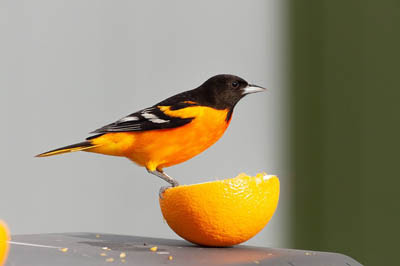 |
| Baltimore Oriole. Michael McGough. Pixabay. |
Males have a black hood and back. Wings black with white patches. Tail black with orange sides to the base. Bright orange under parts.
Females are similar to males, but more olive above, less black. Immature birds for their first year or more are olive above orangish-yellow on the breast, fading to yellow on the belly. Two white wing bars.
These birds are common in deciduous woods, shade trees.
Baltimore Orioles are summer residents throughout Vermont.
Wood Thrush
These spotted birds with the orange-brown upper parts tend to hide in understory trees and on the forest floor.
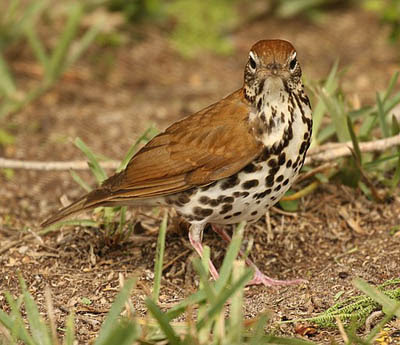 |
| Wood Thrush. Tony Castro. CC BY-SA 4.0 |
These birds are reddish brown on the upper parts, especially rusty orange on the crown and upper back. White eye ring. Large heavy black spots on the under parts.
They live in deciduous and mixed woods. Spend much time on the ground, shuffling through the leaf litter.
Wood Thrushes are summer residents throughout Vermont.
Eastern Towhee
These birds with rusty-orange sides like to hide in dense bushes.
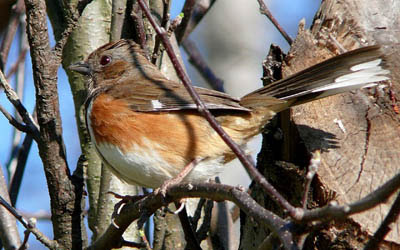 |
| Female Eastern Towhee. Skeeze. Pixabay. |
Males are black above with white wing patch, white tail corners. The sides are rusty. The belly white. Eyes variable: brown, red, orange, white, tending toward whiter southward.
Females are similar, but upper parts brown.
These birds are found in forest understory, dense brush, backyard hedges. Come to feeders.
Eastern Towhees are summer residents throughout most of Vermont, absent in northeastern Vermont.
Yellow birds of Vermont
Yellow is a common bird color! Often it is mixed with black and white plumage in birds.
Many birds with darker upper parts have yellow breast or belly.
The following are yellow birds you are most likely to see in Vermont.
American Goldfinch
These small little birds are bright yellow and black.
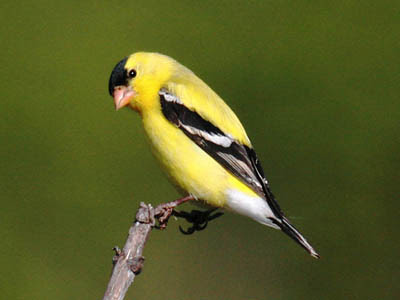 |
| American Goldfinch. Greg Gillson. |
Males are bright lemon yellow with black and white wings and tail, black cap. White under tail coverts. Pink billFemales are duller yellow below and brownish above. Lack black cap.
Winter birds are pale brown or gray, a touch of yellow on the throat of males.
These are birds of open country, fields with saplings, clear cuts, residential areas. They avoid dense forests, mountains, deserts. They visit feeders.
American Goldfinches are year-round residents throughout Vermont.
Cedar Waxwing
These crested birds with yellow band on the end of the tail are often found in flocks. They eat flying insects in summer, fruit and berries the rest of the year.
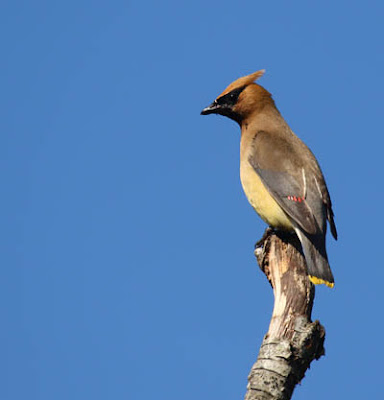 |
| Cedar Waxwing. Greg Gillson. |
These birds are fawn-brown above, with dark gray wings and tail. They have a black mask and wispy crest. The belly is yellow. The wings have waxy red drops on the end of the tertials. The end of the tail has a brilliant yellow tail band.
They are found in open habitats with berries, including juniper woodlands and towns in winter.
Cedar Waxwings are year-round residents throughout Vermont.
Common Yellowthroat
These buttery yellow birds are abundant in the marsh vegetation.
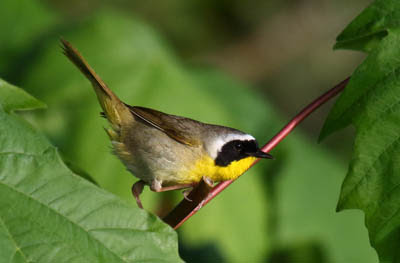 |
| Male Common Yellowthroat. Greg Gillson. |
These skulkers have bright yellow throats and yellow undertail coverts. Males have a black domino mask edged broadly in white, which females lack. Upperparts are dull olive-green.
Immature males in fall show a shadowed black mask.
Found in damp situations and heavy deciduous brambles following clear cuts.
Common Yellowthroats are summer residents throughout Vermont.
Northern Flicker
These woodpeckers spend much time eating ants on the ground.
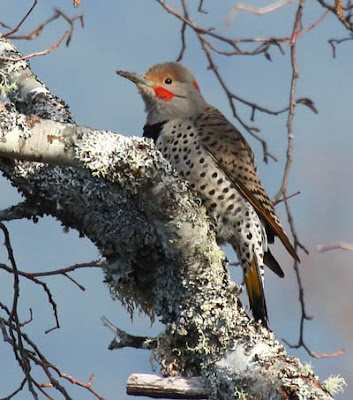 |
| Northern Flicker. Greg Gillson. |
These birds are larger than robins with brown and black barred upper parts. The underparts are pink with round black spots. There is a black crescent across the chest. When they fly away from you they reveal a large white rump.
Western birds have salmon-red under wings and under tail. Those in the East are colored yellow. The male face differs between the two populations–black whisker on the eastern birds, red whisker on western birds. Intergrades from overlap on Great Plains common. These may show male facial characteristics of both populations, or yellow-orange flight feathers.
These birds live in open woods with bare ground for foraging, residential yards.
Northern Flickers are year-round residents throughout Vermont.
Yellow-rumped Warbler
These are abundant warblers across North America. Affectionately called “butter butts” by many birders, because of their bright yellow rumps that flash in flight.
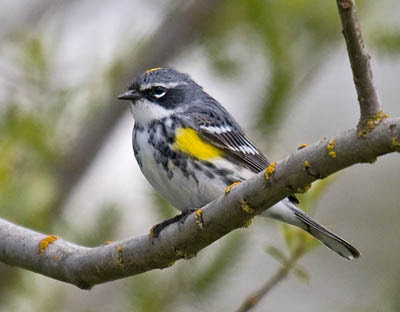 |
| Myrtle Yellow-rumped Warbler. Greg Gillson. |
Western form (Audubon’s) with bright yellow throat and yellow rump. Large white wing patch.
Northern and Eastern form (Myrtle) with white throat, yellow rump, and two white wing bars.
Winter birds are dull gray-brown, with bright yellow rump. Throat may be cream colored or white. Often difficult to tell the two forms apart in winter.
 |
| Winter Yellow-rumped Warbler. Greg Gillson. |
Breed in mountain or boreal conifers. Widespread in migration. Winter in low river bottoms, open weedy deciduous areas. Rarely come to feeders in winter.
Yellow-rumped Warblers are summer residents throughout Vermont.
Yellow Warbler
The golden yellow sun packed all into one little bird! Appears to be an all-yellow bird.
 |
| Yellow Warbler. Greg Gillson. |
Some populations are bright yellow, some tend toward greenish on upper parts, some more golden. Yellow internal tail corners in flight.
Males with red breast streaking, again, variable by population.
Females somewhat, to much, paler yellow, some greenish, some whitish. Lack red streaks.
These birds are found in willow thickets on the edge of wetlands and ditches, stream sides in arid regions.
Yellow Warblers are summer residents throughout Vermont.
Black-throated Green Warbler
Look for these birds with the yellow faces singing high up in the trees in spring.
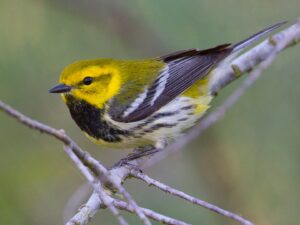
Males in spring have green back and crown, black throat, circling a bright yellow face.
Females and immatures in fall have a white throat. Greenish ear patch.
Found in many forest types, conifers, mixed forests, and cypress.
Black-throated Green Warblers are summer residents throughout Vermont.
Great Crested Flycatcher
These flycatchers have long tails and big heads with big bill and bright yellow belly.
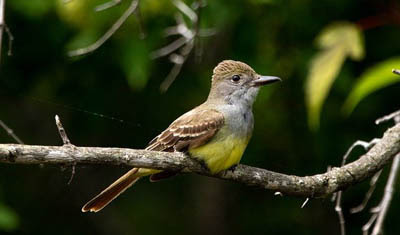 |
| Great Crested Flycatcher. Simard Francois. Pixabay. |
These birds are gray on the face and breast, brownish on rest of upper parts. Bright lemon-yellow belly. The under side of the tail and some feathers of the wing are cinnamon colored.
These birds stay in the canopy of open woods.
Great Crested Flycatchers are summer residents throughout Vermont.
Northern Parula
This is a handsome blue and yellow warbler.
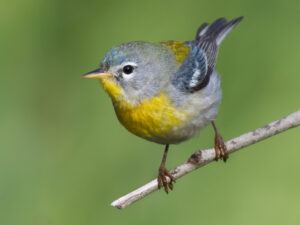
Males are blue on the hood and shoulders. Back green. Yellow throat and breast with a dark red spot mid-chest. Broken white eye ring. Two wide white wing bars.
Females are similar, but paler.
They are found along streams and in swampy forests with willows, maples, birches, hemlocks and other trees.
Northern Parulas are spring and fall migrants only in western Vermont, summer residents in eastern Vermont.
Magnolia Warbler
These common warblers are bright yellow below.
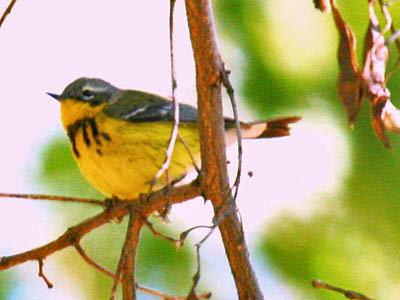 |
| Magnolia Warbler. Greg Gillson. |
Adult males are gray and black above and bright yellow below. Black mask and lower face. Gray crown. Black upper back. Black necklace that breaks into streaks down the breast. White under tail coverts. White under tail base, black terminal tail feathers. Large white wing patch.
Female with two wing bars, black mostly replaced with olive. Immatures for the first year lack black markings.
Live in moist coniferous forests, young stands of spruce and hemlock.
Magnolia Warblers are summer residents throughout Vermont.
Pine Warbler
This yellow and gray bird is one of the few warblers to visit feeders–and the only one to eat seeds!
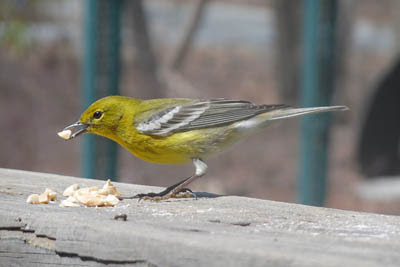 |
| Pine Warbler. Nikolaus Schultz. Pixabay. |
These birds are yellow-green on head, back, and breast. Wings blue-gray with wide white wing bars. Yellow split eye ring.
Strongly associated with pine forests. Usually high in treetops.
Pine Warblers are summer residents throughout Vermont.
Wrapping Up
Vermont may boast some very colorful avian residents but there are also some stunning black and white birds to be found there as well. Here are my favorites:
- Black-and-white Warbler: This strikingly patterned warbler lives up to its name with bold stripes covering its entire body. Look for them actively foraging through branches in mature deciduous and coniferous forests.
- Downy Woodpecker: These tiny woodpeckers have a black back with white streaks, a small white belly, and a distinctive red spot on the back of the male’s head. They frequent a variety of wooded habitats, often drumming on trees to search for insects.
- Black-capped Chickadee: These acrobatic songbirds wear a black cap, bib, and back, contrasting with white cheeks and underparts. They flit through branches, uttering their cheerful “chick-a-dee” call.
- White-breasted Nuthatch: This active climber has a black cap and back, white underparts, and a long, pointed bill. They readily visit feeders and are adept at navigating tree trunks in search of insects and nuts.
- European Starling: Introduced but widespread, starlings have iridescent black plumage with a green-purple sheen in breeding season. Flocks gather in open areas and on rooftops, creating a noisy presence.
Frequently Asked Questions
What are the bright yellow birds in Vermont?
Vermont may not be bursting with tropical hues, but it still offers several vibrant yellow feathered friends to brighten your day. Here are some top contenders for bright yellow birds you might encounter:
- American Goldfinch: This charming songbird is a common year-round resident, especially in fields, meadows, and backyards. Males sport a bright yellow body with black wings and cap, while females are less striking but still show a lovely yellow wash.
- Yellow Warbler: A summer visitor to Vermont, this warbler thrives in wet thickets, willow swamps, and roadsides. Look for their brilliant yellow plumage, chestnut streaks on the male’s breast, and yellow patches on the tail when fanned.
- Common Yellowthroat: These songbirds prefer shrubby areas and meadows. Males boast a bright yellow throat and breast, contrasting with a dark mask and olive-green upperparts. Females are less vibrant but still show a yellowish wash.
What is the rust colored bird in Vermont?
The Hermit Thrush, Vermont’s beloved state bird, is a beautiful and elusive songbird found throughout the Green Mountain State. However, knowing where to look can significantly increase your chances of spotting this shy avian resident. Here are some tips to guide your Hermit Thrush quest:
Habitat:
- Forest Interiors: Hermit Thrushes prefer the quiet seclusion of mature forests, particularly those with mixed deciduous and coniferous trees. Look for areas with dense understory vegetation and openings like small meadows or ponds.
- Mountain Slopes: These thrushes thrive at higher elevations, particularly on wooded slopes and ravines. Explore state forests and parks located in Vermont’s mountainous regions.
- Humid Areas: They seek moist environments, so areas near streams, brooks, or damp woodlands are promising locations.
Time of Year:
- Spring and Summer: Look for Hermit Thrushes from April to October, as these are their breeding and nesting seasons. Their beautiful, flute-like song is most readily heard during this period, often at dawn and dusk.
- Fall: While less common, you might still encounter them during their fall migration, typically from late September to mid-November.
What are the little red birds in Vermont?
The Common Redpoll is a small songbird in the finch family. It’s classified as:
- Species: Acanthis flammea
- Genus: Acanthis (meaning “thorn” in Greek, likely referring to the birds’ beaks)
- Family: Fringillidae (finch family)
- Order: Passeriformes (perching birds)
Within the finch family, the common redpoll belongs to the subfamily Carduelinae, which includes various seed-eating finches like goldfinches, siskins, and redcrossbills. These birds are generally known for their beautiful songs and colorful plumage, and the common redpoll is no exception.
Here are some additional details about the common redpoll:
- Appearance: They are small birds, measuring around 4.5-5.5 inches in length. They have brown and white streaked plumage, a bright red forehead patch, and a black bib. Males often have a pink wash on their chest and breast.
- Habitat: Common redpolls prefer open woodlands, tundra, and taiga with thickets and shrubs. They also readily visit feeders, especially during winter when their natural food sources are scarce.
- Diet: They primarily feed on seeds, buds, and berries. They are agile at hanging upside down while foraging on catkins and cones.
- Distribution: Common redpolls are found in North America, Europe, and Asia. In North America, they breed in the Arctic and northern boreal forests and migrate south in winter, sometimes reaching the central United States.
Related Articles:
See photos and learn about the most common backyard birds in Vermont, regardless of color.
Here’s a quick tutorial of how I would teach you to identify birds: 7 Steps to Identify Birds!
Birds with red heads in North America.
Yellow-and-black birds in North America.
Little Brown Birds at your Feeder.



